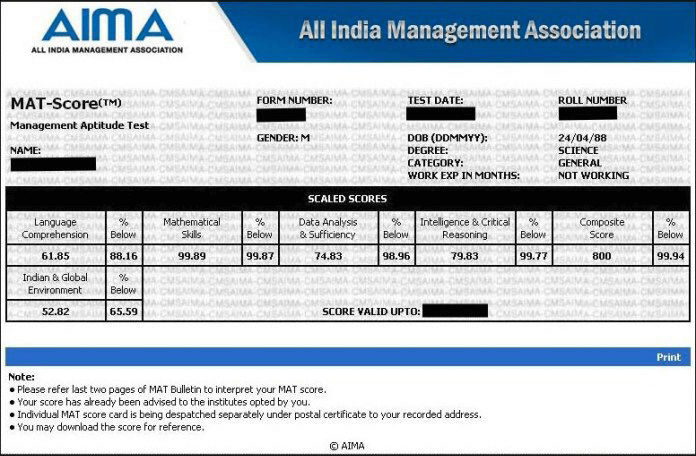5800 students unlocked their dream jobs with UG/PG programs in top colleges. Apply Now!
With the MAT results finally out, a lot has been buzzing in the management sphere. The young aspirants today are seizing every opportunity possible so that they could get a step closer to fulfilling their career ambition. But what if your MAT percentile does not directly equate with getting you closer to that ambition? Well, Fret not and evaluate your options within your range!
MAT Marking Scheme
The marking scheme for MAT is as follows -
- One mark for every correct answer
- Penalty of 0.25 marks for each incorrect answer
- Total scaled score is 800
The Management Aptitude Test (MAT) is a national level entrance exam conducted by AIMA for MBA/PGDM admissions into the management colleges across India. AIMA specifies the MAT exam pattern 2025 in detail and candidates can check the same on mat.aima.in. The exam duration is 150 minutes with a total of 200 questions asked over 5 sections.
MAT Key Highlights
| Specifics | Details |
| Exam name | Management Aptitude Test (MAT) |
| Conducting body | All India Management Association (AIMA) |
| Exam level | National level |
| MOde | IBT |
| Duration | 2.5 hours (150 minutes) |
| Question type | MCQ's |
| Negative marking | Yes |
| Sections | 5 sections with 40 questions each |
What is MAT Scaled Score?
A scaled score is a representation of the total number of correct questions a candidate has answered (raw score) that has been converted onto a consistent and standardized scale. MAT scores are scaled to 100 for each section. The scaled score is, therefore, awarded in the scorecard in the range of 0-100 in each section.
How to Calculate MAT Scaled Score?
Here's what a MAT scorecard looks like

MAT Scorecard
The section-wise score mentioned in the MAT scorecard is scaled scores. These are calculated on the basis of the marks obtained by the student in each section.
- Each section has 40 questions with 1 mark each. This sets the maximum achievable score at 40.
- The raw scores then obtained by a student in the MAT exam are scaled from 0 to 100.
- As MAT is conducted 4 times a year, the score is scaled to adjust the difference on the basis of the varying difficulty of each exam.
- Scaled scores are required to accurately depict a student's ability and performance in the MAT exam, compared to other candidates sitting for the exam.
- AIMA reports scores above 20 & 80 are a rare occurrence.
What is The MAT Composite Score?
the MAT composite score is indicated for the marks calculated on the basis of performance in the first four sections of the examination. The following points listed by AIMA further illustrate the calculation of the MAT composite score.
- The MAT composite score is given on a scale of 199 to 801. The composite score on MAT exam result, less than 200 or more than 800 is rare.
- Sectional MAT scores less than 20 and more than 80 are rare.
- All scores below 200 are stated as 199 and all scores above 800 are reported as 801. This means, even if students get less than 199, their composite score will be reported as 199. Similarly, for MAT scores above 801, it will be reported as 801 only.
What is MAT percentile?
This MAT percentile can be understood as the percentage of all students who scored below one student based on the administration of the entire examination.
How to calculate MAT percentile
MAT percentile = (Composite Score obtained by a Candidate)X 100
Total number of candidates
Percentile shows the number of students who scored less than a particular student in the MAT exam.
Difference between MAT Score and Percentile
- The MAT score is the total marks obtained by the candidates in all the sections of the MAT entrance examination.
- The MAT percentile is the score obtained by a candidate. It shows the percentage of students who scored lower than the candidate in MAT 2021.
What to do after low MAT percentile
Analyse your profile
During MBA admissions, aspirants often miss out on the fact that an average MAT percentile could be easily covered up with an impeccable MBA profile. So, MBA aspirants must focus on creating an excellent profile that reflects suitable qualifications and potential for admission to business schools. Apart from having a noteworthy career and academic performance, candidates must also make sure that their profile includes an X-factor which can differentiate them amidst similar aspirants.
Apply to B-schools accepting your MAT score
Scoring a percentile below 70 in the MAT exam is not the end of the world. Sure you missed out on most of the high-profile MBA institutes, but there is a lot of other Tier-2, Tier-3 MBA colleges that accept aspirants with an average MAT percentile. These management institutes surely do not own a high reputation or popularity among MBA professionals but could provide you with industry-synced, affordable management education.
Read more: How Lesser-known Management Colleges Could Be the Right Choice?
Prepare for GD/PI
Once you have sorted out your management profile and applied to your targeted B-schools, the next step requires you to work on your soft skills. Group discussions/Personal Interviews hold as much importance as an excellent management profile. A MAT percentile less than 70 can be overshadowed by an outstanding group discussion and personal interview.
During group discussions, you can showcase your communication skills and presence of mind. While in the personal interview, you have the chance to represent yourself as an ambitious management aspirant by sharing your strengths and highlighting the achievements of your past work experiences. Ultimately, these two rounds combined, offer you a second chance to convince the interviewers to take you for their prominent MBA program even after an average MAT percentile.
Go for State Level Exams
If you are not satisfied with the college options available according to your February MAT percentile, then you can further give State-level Management entrance exams. Many students are so focussed towards national level MBA exams like MAT, CAT, SNAP etc that they lose out the opportunity to get into government MBA institutes via state level exams. The competition scale of these exams are low and thus, can offer you a higher chance of success.
Given below is a table with the states that conduct state level MBA entrance exams for your knowledge.
|
State |
MBA Entrance Exam | Exam Date (tentative) |
| Andhra Pradesh | AP ICET |
First week of March |
|
Karnataka |
PGCET |
June |
|
Madhya Pradesh |
MP MET | March |
|
Maharashtra |
MAH CET | March |
|
Odissa |
OJEE |
May |
|
Tamil Nadu |
TANCET | March |
|
Telangana |
TS ICET |
May |
| Uttar Pradesh | UPSEE |
May |
Thus, as observed from the above table, MBA aspirants who are not satisfied with their MAT percentile can always have state level MBA entrance exams as their second chance to succeed.
MBA aspirants wanting to take admission into management colleges via MAT percentile are in an advantage over other candidates as MAT exam is conducted four times in a year. Thus, if you are unhappy with your MAT-February score, you can apply for MAT exam again in September 2025. Fortunately, MBA college admissions are open for the year and they accept MAT-MAY score as well. A higher percentile as MAT score for the month of May will open more gates of MBA colleges for you.
Revise your Preparation Strategy
Before going for another MBA entrance exam, be it state level exams or MAT, you must go through your exam preparation strategy thoroughly and look for the week points. You must analyse where you went wrong with your February MAT preparations and focus on not repeating the same mistakes. Retracing your steps to identify the areas of improvement will enhance your MBA entrance exam preparation and help you score a higher percentile.
In conclusion, you must never lose hope. MAT is just one way to get into your targeted MBA institute. You will get multiple options and ways to succeed and become an Industry ready professional with a prosperous career.
HELP
Take the first step towards your dream job.
ABOUT THE AUTHOR

